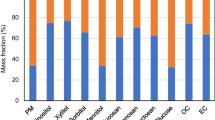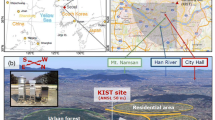Abstract
PM1 aerosol characterization on organic tracers for biomass burning (levoglucosan and its isomers and dehydroabietic acid) was conducted within the AERTRANS project. PM1 filters (N = 90) were sampled from 2010 to 2012 in busy streets in the urban centre of Madrid and Barcelona (Spain) at ground-level and at roof sites. In both urban areas, biomass burning was not expected to be an important local emission source, but regional emissions from wildfires, residential heating or biomass removal may influence the air quality in the cities. Although both areas are under influence of high solar radiation, Madrid is situated in the centre of the Iberian Peninsula, while Barcelona is located at the Mediterranean Coast and under influence of marine atmospheres. Two extraction methods were applied, i.e. Soxhlet and ASE, which showed equivalent results after GC-MS analyses. The ambient air concentrations of the organic tracers for biomass burning increased by an order of magnitude at both sites during winter compared to summer. An exception was observed during a PM event in summer 2012, when the atmosphere in Barcelona was directly affected by regional wildfire smoke and levels were four times higher as those observed in winter. Overall, there was little variation between the street and roof sites in both cities, suggesting that regional biomass burning sources influence the urban areas after atmospheric transport. Despite the different atmospheric characteristics in terms of air relative humidity, Madrid and Barcelona exhibit very similar composition and concentrations of biomass burning organic tracers. Nevertheless, levoglucosan and its isomers seem to be more suitable for source apportionment purposes than dehydroabietic acid. In both urban areas, biomass burning contributions to PM were generally low (2 %) in summer, except on the day when wildfire smoke arrive to the urban area. In the colder periods the contribution increase to around 30 %, indicating that regional biomass burning has a substantial influence on the urban air quality.




Similar content being viewed by others
References
Alier M, van Drooge BL, Dall’Osto M, Querol X, Grimalt JO, Tauler R (2013) Source apportionment of submicron organic aerosol at an urban background and a road site in Barcelona (Spain) during SAPUSS. Atmos Chem Phys 13:10353–10371. doi:10.5194/acp-13-10353-2013
Caseiro A, Oliveira C (2012) Variations in wood burning organic marker concentrations in the atmosphere of four European cities. J Environ Monit 14:2261–2269. doi:10.1039/c2em10849f
Dall’Osto M, Querol X, Alastuey A, Minguillon MC, Alier M, Amato F et al (2013) Presenting SAPUSS: solving aerosol problem by using synergistic strategies at Barcelona, Spain. Atmos Chem Phys 13:8891–9019. doi:10.5194/acp-13-8991-2013
Engling G, Carrico CM, Kreidenweis CM, Collet JL Jr, Day DE, Malm WC et al (2006) Determination of levoglucosan in biomass combustion aerosol by high-performance anion exchange chromatography with pulsed amperometric detection. Atmos Environ 40:299–311. doi:10.1016/j.atmosenv.2005.12.069
Fabbri D, Modelli S, Torri C, Cemin A, Ragazzi M, Scaramuzza P (2008) GC-MS determination of levoglucosan in atmospheric particulate matter collected over different filter materials. J Environ Monit 12:1519–1523. doi:10.1039/b808976k
Fine PM, Cass GR, Simoneit BRT (2004) Chemical characterization of fine particle emissions from the fireplace combustion of wood types grown in the Midwestern and Western United States. Environ Eng Sci 21(3):387–409. doi:10.1089/109287504323067021
Forster P, Ramaswamy V et al. (2007) Changes in Atmospheric Constituents and in Radiative Forcing. In: IPCC, 2007, Climate Change 2007: The Physical Science Base. Contribution of Working Group I to the fourth Assessment Report of the IPCC, ISBN: 978 0521 88009–1
Fraser MP, Lakshmanan K (2000) Using levoglucosan as a molecular marker for the long-range transport of biomass combustion aerosols. Environ Sci Technol 34:4560–4564. doi:10.1021/es991229I
Gonçalves C, Alves C, Fernandes AP, Monteiro C, Tarelho L, Evtyugina M, Pio C (2011) Organic compounds in PM2.5 emitted from fireplace and woodstove combustion of typical Portuguese wood species. Atmos Environ 45:4533–4545. doi:10.1016/j.atmosenv.2011.05.071
He L, Hu M, Huang X, Yu B, Zhang Y, Liu D (2004) Measurement of emissions of fine particulate organic matter from Chinese cooking. Atmos Environ 38:6557–6564. doi:10.1016/j.atmosenv.2004.08.034
Hennigan CJ, Sulivan AP, Collett JL, Robinson AL (2010) Levoglucosan stability in biomass burning particles exposed to hydroxyl radicals. Geophys Res Lett 37, L09806. doi:10.1029/2010GL043088
Hoffmann D, Tilgner A, Iinuma Y, Herrmann H (2010) Atmospheric stability of levoglucosan: a detailed laboratory and modeling study. Environ Sci Technol 44:694–699. doi:10.1021/es902476f
Hou X, Zhuang G, Lin Y, Li J, Jiang Y, Fu JS (2008) Emission of fine organic aerosol from traditional charcoal broiling in China. J Atmos Chem 61:119–131. doi:10.1007/s10874-009-9128-3
Lee JL, Engling G, Lung SC, Lee KY (2008) Particle size characteristics of levoglucosan in ambient aerosols from rice straw burning. Atmos Environ 42:8300–8308. doi:10.1021/es902476f
Medeiros PM, Simoneit BRT (2007) Analysis of sugars in environmental samples by gas chromatography–mass spectrometry. J Chromatogr A 1141:271–278. doi:10.1016/j.chroma.2006.12.017
Mochida M, Kawamura K, Fub P, Takemura T (2010) Seasonal variation of levoglucosan in aerosols over the western North Pacific and its assessment as a biomass-burning tracer. Atmos Environ 44:3511–3518. doi:10.1016/j.atmosenv.2010.06.017
Oliveira C, Pio C, Alves C, Evtyungina M, Santos P, Gonçalves V et al (2007) Seasonal distribution of polar organic compounds in the urban atmosphere of two large cities from the North and South of Europe. Atmos Environ 41:5555–5570. doi:10.1016/j.atmosenv.2007.03.001
Pérez N, Pey J, Cusack M, Reche C, Querol X, Alastuey A, Viana M (2010) Variability of particle number, black carbon and PM10, PM2.5 and PM1 levels and speciation: influence of road traffic emissions on urban air quality. Aerosol Sci Technol 44:487–499. doi:10.1080/02786821003758286
Phuleria HC, Fine PM, Zhu Y, Sioutas C (2005) Air quality impacts of the October 2003 Southern California wildfires. J Geophys Res 110:D07S20. doi: 10.1029/2004JD004626
Pope CA III, Burnett RT, Thun MJ, Calle EE, Krewski D, Ito K, Thurston GD (2002) Lung cancer, cardiopulmonary mortality, and long-term exposure to fine particulate air pollution. JAMA 287:1132–1141
Puxbaum H, Caseiro A, Sánchez-Ochoa A, Kasper-Giebl A, Cleays M, Gelencsér A, Legrand M, Preunkert S, Pio C (2007) Levoglucosan levels at background sites in Europe for assessing the impact of biomass combustion on the European aerosol background. J Geophys Res 112:D23S05. doi: 10.1029/2006JD008114.
Querol X, Alastuey A, Moreno T, Viana MM, Castillo S, Pey J, Rodríguez S, Artiñano B, Salvador P, Sánchez M, Garcia Dos Santos S, Herce Garraleta MD, Fernandez-Patier R, Moreno-Grau S, Negral L, Minguillón MC, Monfort E, Sanz MJ, Palomo-Marín R, Pinilla-Gil E, Cuevas E, de la Rosa J, Sánchez de la Campa A (2009) Spatial and temporal variations in airborne particulate matter (PM10 and PM2.5) across Spain 1999–2005. Atmos Environ 42:3964–3979. doi:10.1016/j.atmosenv.2006.10.071
Reche C, Viana M, Amato F, Alastuey A, Moreno T, Hillamo R, Teinilä K, Saarnio K, Seco R, Peñuelas J, Mohr C, Prévôt A, Querol X (2012) Biomass burning contributions to urban aerosols in a coastal Mediterranean city. Sci Tot Environ 427–428:175–190. doi:10.1016/j.scitotenv.2012.04.012
Rolph GD (2003) Real-time Environmental Applications and Display sYstem (READY) Website (http://www.arl.noaa.gov/ready/hysplit4.html). NOAA Air Resources Laboratory, Silver Spring, MD
Sillanpää M, Frey A, Hillamo R, Pennanen AS, Salonen O (2005) Organic, elemental and inorganic carbon in particulate matter of six urban environments in Europe. Atmos Chem Phys 5:2869–2879
Simoneit BRT (2002) Biomass burning—a review of organic tracers for smoke from incomplete combustion. Appl Geochem 17:29–162. doi:10.1016/S0883-2927(01)00061-0
Simoneit BRT, Schauer JJ, Nolte CG, Oros DR, Elias VO, Fraser MO et al (1999) Levoglucosan, a tracer for cellulose in biomass burning and atmospheric particles. Atmos Environ 33:173–182
Szidat S, Prévôt ASH, Sandradewi J, Alfarra MR, Synal H-A, Wacker L et al (2007) Dominant impact of residential wood burning on particulate matter in Alpine valleys during winter. Geophys Res Lett 34, L05820. doi:10.1029/2006GL02832
van Drooge BL, Lopez J, Grimalt JO (2012) Influences of natural emission sources (wildfires and Saharan dust) on the urban organic aerosol in Barcelona (Western Mediterranean Basis) during a PM event. Environ Sci Pollut Res 19:4159–4167. doi:10.1007/s11356-012-0890-4
Vicente A, Alves C, Monteiro C, Nunes T, Mirante F, Cerqueira M, Calvo A, Pio C (2012) Organic speciation of aerosols from wildfires in central Portugal during summer 2009. Atmos Environ 57:186–196. doi:10.1016/j.atmosenv.2012.04.030
Vicente A, Alves C, Calvo A, Fernandez A, Nunes T, Almeida SM, Pio C (2013) Emission factors and detailed chemical composition of smoke particles from the 2010 wildfire season. Atmos Environ 71:295–303. doi:10.1016/j.atmosenv.2013.01.062
Acknowledgments
This work was supported by the scientific research projects AERTRANS (CTQ2009-14777-C02-01) and TEAPARTICLE (CGL2011-29621).
Author information
Authors and Affiliations
Corresponding author
Additional information
Responsible editor: Constantini Samara
Electronic supplementary material
Below is the link to the electronic supplementary material.
ESM 1
(DOCX 2499 kb)
Rights and permissions
About this article
Cite this article
van Drooge, B.L., Fontal, M., Bravo, N. et al. Seasonal and spatial variation of organic tracers for biomass burning in PM1 aerosols from highly insolated urban areas. Environ Sci Pollut Res 21, 11661–11670 (2014). https://doi.org/10.1007/s11356-014-2545-0
Received:
Accepted:
Published:
Issue Date:
DOI: https://doi.org/10.1007/s11356-014-2545-0




